What is JDBC ?
JDBC stands for Java Database Connectivity,
which is a standard Java API for database-independent connectivity
between the Java programming language and a wide range of databases.
The JDBC library includes APIs for each of the tasks commonly associated with database usage:
- Making a connection to a database
- Creating SQL or MySQL statements
- Executing that SQL or MySQL queries in the database
- Viewing & Modifying the resulting records
JDBC Architecture :
The JDBC API uses a driver manager and database-specific drivers to provide transparent connectivity to heterogeneous databases.The JDBC driver manager ensures that the correct driver is used to access each data source. The driver manager is capable of supporting multiple concurrent drivers connected to multiple heterogeneous databases.
Following is the architectural diagram, which shows the location of the driver manager with respect to the JDBC drivers and the Java application:
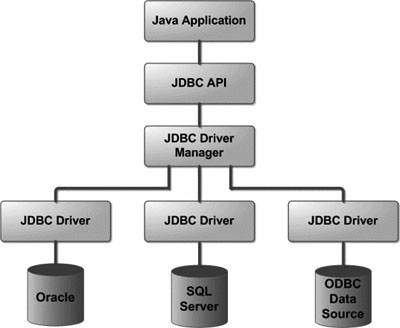
JDBC Driver Type :
Type 1: JDBC-ODBC Bridge Driver:
In a Type 1 driver, a JDBC bridge is used to access ODBC drivers installed on each client machine. Using ODBC requires configuring on your system a Data Source Name (DSN) that represents the target database.When Java first came out, this was a useful driver because most databases only supported ODBC access but now this type of driver is recommended only for experimental use or when no other alternative is available.
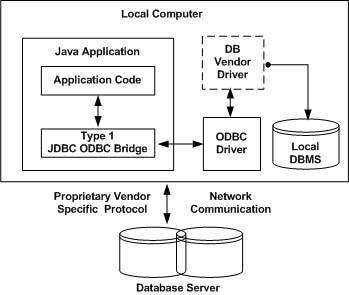
Type 2: JDBC-Native API:
In a Type 2 driver, JDBC API calls are converted into native C/C++ API calls which are unique to the database. These drivers typically provided by the database vendors and used in the same manner as the JDBC-ODBC Bridge, the vendor-specific driver must be installed on each client machine.If we change the Database we have to change the native API as it is specific to a database and they are mostly obsolete now but you may realize some speed increase with a Type 2 driver, because it eliminates ODBC's overhead.
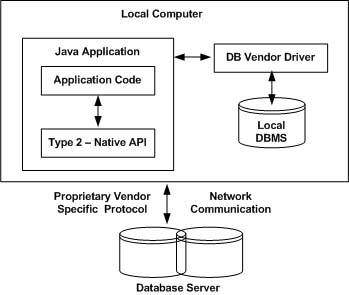
Type 3: JDBC-Net pure Java:
In a Type 3 driver, a three-tier approach is used to accessing databases. The JDBC clients use standard network sockets to communicate with an middleware application server. The socket information is then translated by the middleware application server into the call format required by the DBMS, and forwarded to the database server.This kind of driver is extremely flexible, since it requires no code installed on the client and a single driver can actually provide access to multiple databases.
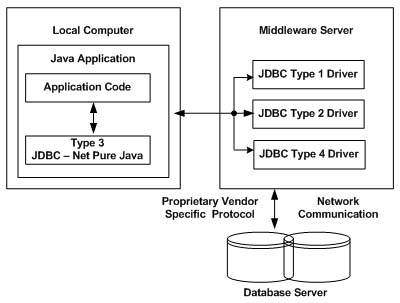
Your application server might use a Type 1, 2, or 4 driver to communicate with the database, understanding the nuances will prove helpful.
Type 4: 100% pure Java:
In a Type 4 driver, a pure Java-based driver that communicates directly with vendor's database through socket connection. This is the highest performance driver available for the database and is usually provided by the vendor itself.This kind of driver is extremely flexible, you don't need to install special software on the client or server. Further, these drivers can be downloaded dynamically.
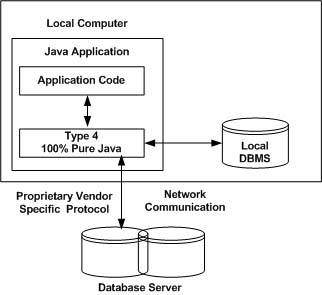
How to Insert JDBC Driver Class in IDE ?
To Insert SQL Driver Class in Our Working IDE first we have to Add the JAR File Of that Database Connectivity Bridge and then Write :
Class.forName(Location_Of_Driver_Class).newInstance();
How to Establish Connection & Execute SQL Query in Java ?
Here is a Simple Example How You Can Execute Query in Java. We are using MySQL Driver Here :
Included Package :try {Class.forName("com.mysql.jdbc.Driver").newInstance();Connection conn= DriverManager.getconnection("jdbc:mysql://localhost:3306/databasename","username","password");Statement stmt = conn.createStatement();ResultSet rs;rs=stmt.executeQuery("SELECT * FROM STUDENT");//Your Operation}catch (SQLException e) {e.printStackTrace();}
import java.sql.*;
For Further Reading,

0 comments:
Post a Comment